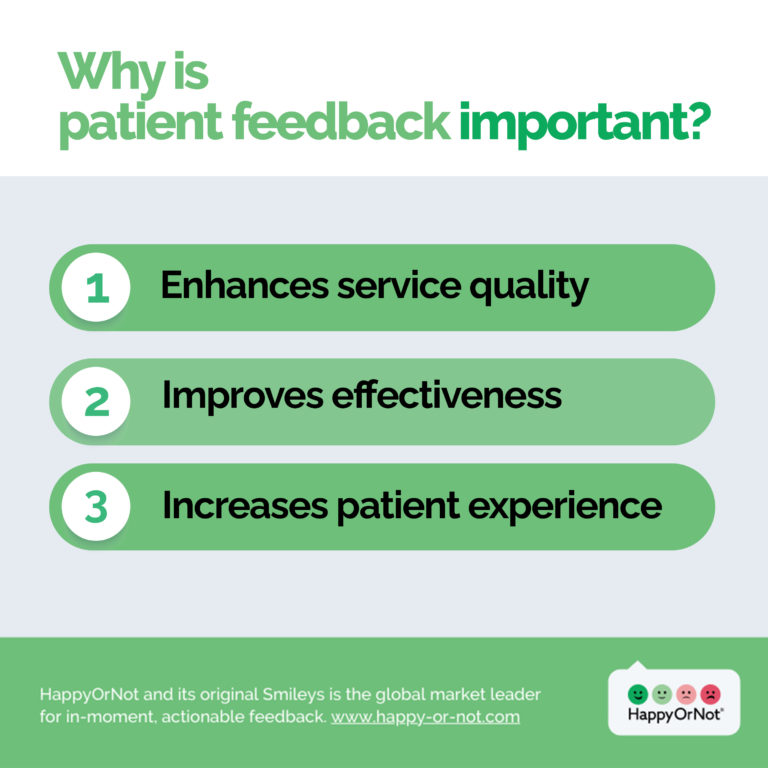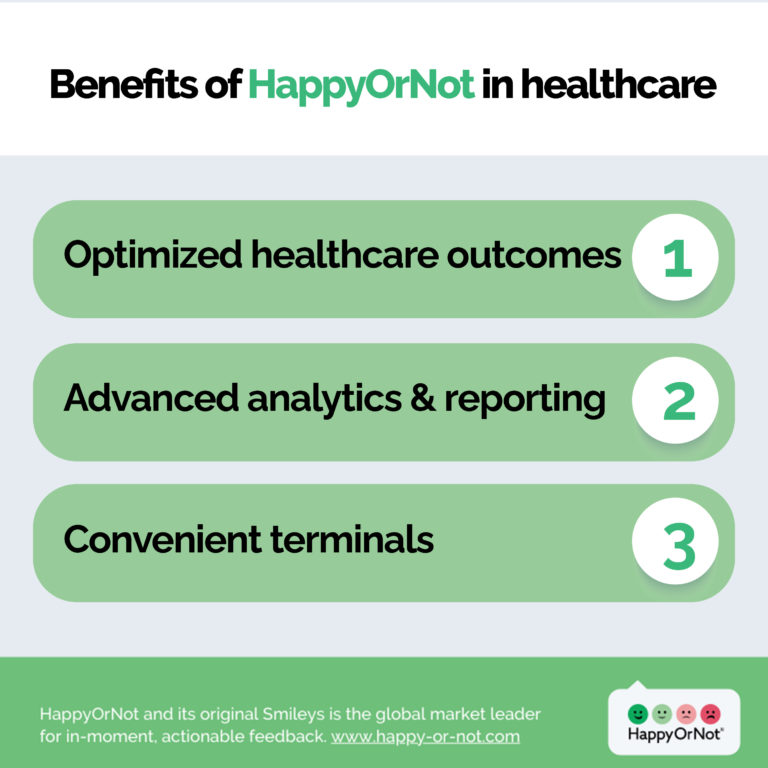What tool provides feedback on customer patient experience?
Understanding the patient experience is crucial for healthcare providers to deliver high-quality care and ensure patient satisfaction. Patient experience encompasses various aspects, including patient-centered care, overall satisfaction, and healthcare service quality.
In this article, we explore the importance of understanding the patient experience in healthcare and introduce HappyOrNot as a tool for gathering feedback on the customer’s patient’s experience.
Understanding the patient experience
Patient satisfaction surveys are vital in measuring health care quality and evaluating patient feedback. These surveys enable healthcare providers to assess the effectiveness of their services, identify strengths and weaknesses, and make informed decisions to enhance patient care.
By collecting feedback on various aspects of patient care, including well-being, easy access, and the quality of care received, healthcare providers can comprehensively understand the patient experience and drive continuous improvement.
Why patient feedback is so important
Patient feedback is incredibly vital for several reasons. First and foremost, it provides valuable insights into the quality of healthcare services provided. Patients are the direct recipients of these services, and their feedback offers a unique perspective on the effectiveness and efficiency of medical care.
By actively listening to patient feedback, healthcare providers can identify areas that need improvement, whether it’s related to the staff’s bedside manner, waiting times, or the overall patient experience. This feedback helps medical professionals to continuously enhance the quality of care they provide, ensuring that patients’ needs and expectations are met.

HappyOrNot as a patient feedback tool
Through anonymous and intuitive surveys, HappyOrNot enables patients to provide feedback on their healthcare services, making it a powerful tool for measuring healthcare quality and patient satisfaction in real time.
By utilizing simple and concise patient satisfaction survey questions, HappyOrNot ensures patients can quickly and easily provide feedback. This approach not only maximizes survey response rates but improves the accuracy and reliability of data, and offers healthcare providers a continuous pulse on patient satisfaction levels.
Real-time insights for better results
The tool’s real time patient feedback capabilities empower hospitals and healthcare institutions to address patient concerns promptly, enhance patient safety, and optimize healthcare outcomes.
HappyOrNot’s advanced analytics and reporting features provide healthcare providers with actionable data to drive continuous quality improvement and deliver patient-centered care.
HappyOrNot’s user-friendly interface allows patients to provide feedback conveniently through dedicated terminals, mobile devices, and online platforms.

Benefits of using HappyOrNot in healthcare
Replacing traditional patient satisfaction surveys, healthcare providers can gather valuable patient feedback and gain insights into their customer experience with health services. This feedback enables healthcare institutions to identify areas of improvement, enhance the quality of care, and tailor their services to meet patient needs.
HappyOrNot simplifies the process of conducting patient surveys, eliminating the need for lengthy questionnaires or time-consuming phone calls. Patients can provide feedback conveniently and anonymously through HappyOrNot’s Smiley face feedback terminals, and online digital Smileys.
Overcoming challenges in patient feedback
Despite the numerous benefits of gathering patient feedback, healthcare providers often encounter challenges in implementing an effective patient feedback system.
Patient satisfaction surveys
One common challenge is reliance on traditional patient satisfaction surveys, which can be lengthy and complex. To overcome this challenge, healthcare providers can adopt concise, user-friendly, and easy-to-complete patient feedback surveys. By simplifying the survey process, healthcare providers can encourage higher response rates and collect more accurate patient feedback.
Number of healthcare providers
Another challenge in patient feedback is the vast number of healthcare providers and the complexity of the healthcare industry. With many healthcare providers offering various services and operating in different settings, gathering and analyzing feedback from a diverse patient population can be daunting. However, healthcare research and consumer assessment tools like HappyOrNot solve these challenges.
These tools offer the capability to gather information across multiple healthcare settings, including hospitals, clinics, residential care, and other healthcare facilities. They enable healthcare providers to gain insights into the patient experience and make data-driven improvements to enhance healthcare quality, improve patient satisfaction, and optimize health plans.
Utilizing data and analytics for continuous improvement
Patient satisfaction surveys serve as valuable data sources, providing insights into various aspects of the patient experience within a hospital setting. By analyzing the results of these surveys, healthcare providers can identify areas of strength and areas in need of improvement.
For example, if patients consistently report dissatisfaction with the waiting times or the cleanliness of facilities, hospital administrators can take targeted actions to address these issues, leading to enhanced patient satisfaction.
Data analytics
In addition to patient satisfaction surveys, hospitals can also utilize data analytics to examine other key performance indicators, such as hospital readmission rates, patient outcomes, and financial metrics.
By analyzing these data points, healthcare providers can comprehensively understand the hospital’s performance and identify opportunities for improvement.
For instance, if a hospital has higher than average readmission rates, data analytics can help pinpoint potential causes, such as inadequate discharge planning or gaps in post-discharge follow-up care.
The combination of patient experience surveys and other relevant data points enables healthcare providers to make data-driven decisions, identify areas for enhancement, and high-quality healthcare delivery that meets patient expectations.
Frequently asked questions
How can patient satisfaction surveys help healthcare providers enhance the quality of care and meet patient needs?
Patient and customer satisfaction surveys provide insights to improve care quality and meet patient needs effectively.
What advantages does HappyOrNot offer as a patient feedback tool compared to traditional surveys?
HappyOrNot simplifies feedback collection with user-friendly surveys, increasing response rates and providing real-time insights for improved patient satisfaction.
What challenges do healthcare providers face when implementing patient feedback systems?
Lengthy and complex surveys lead to survey fatigue. Simplifying surveys makes it easier for patients to provide feedback and increases response rates.
How can data and analytics be utilized to drive continuous improvement in the patient experience?
Analyzing patient satisfaction surveys and key performance indicators allows healthcare providers to identify areas for improvement and enhance overall patient satisfaction.
What role do patient satisfaction surveys play in enhancing hospital performance and healthcare outcomes?
Patient satisfaction surveys provide valuable data for identifying areas of strength and improvement, enabling targeted interventions and ultimately improving hospital performance and clinical outcomes.